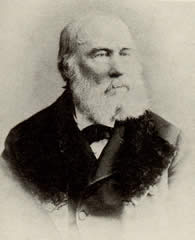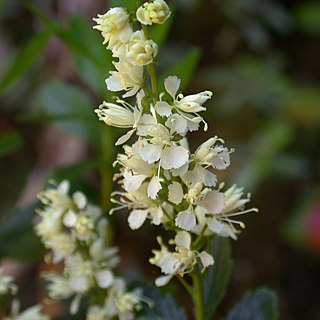
George Bentham was an English botanist, described by the weed botanist Duane Isely as "the premier systematic botanist of the nineteenth century". Born into a distinguished family, he initially studied law, but had a fascination with botany from an early age, which he soon pursued, becoming president of the Linnaean Society in 1861, and a fellow of the Royal Society in 1862. He was the author of a number of important botanical works, particularly flora. He is best known for his taxonomic classification of plants in collaboration with Joseph Dalton Hooker, his Genera Plantarum (1862–1883). He died in London in 1884.

Walter Hood Fitch was a botanical illustrator, born in Glasgow, Scotland, who executed some 10,000 drawings for various publications. His work in colour lithograph, including 2700 illustrations for Curtis's Botanical Magazine, produced up to 200 plates per year.
Dicoelia is a plant genus of the family Phyllanthaceae. It was first described as a genus in 1879. It is native to Borneo and Sumatra.
- Dicoelia beccarianaBenth. - Borneo
- Dicoelia sumatranaWelzen - Sumatra
Maesobotrya is a genus of flowering plant belonging to the family Phyllanthaceae first described as a genus in 1879. It is native to sub-Saharan Africa. It is dioecious, with male and female flowers on separate plants.
Athroostachys is a Brazilian genus of bamboo in the grass family.

A taxonomic system, the Bentham & Hooker system for seed plants, was published in Bentham and Hooker's Genera plantarum ad exemplaria imprimis in herbariis kewensibus servata definita in three volumes between 1862 and 1883.

Icones Plantarum is an extensive series of published volumes of botanical illustration, initiated by Sir William Jackson Hooker. The Latin name of the work means "Illustrations of Plants". The illustrations are drawn from herbarium specimens of Hooker's herbarium, and subsequently the herbarium of Kew Gardens. Hooker was the author of the first ten volumes, produced 1837–1854. His son, Sir Joseph Dalton Hooker, was responsible for Volumes XI-XIX. Daniel Oliver was the editor of Volumes XX-XXIV. His successor was William Turner Thiselton-Dyer. The series now comprises forty volumes.
Aciachne is a genus of Latin American plants in the grass family.
Cleistachne is a genus of African and Asian plants in the grass family. The only known species is Cleistachne sorghoides, native to eastern and southeastern Africa, and parts of Asia.
Craspedorhachis is a genus of African plants in the grass family.
Oxylaena is a genus of flowering plants in the pussy's-toes tribe within the sunflower family.
Heterachne is a genus of Australian plants in the grass family.
Kerriochloa is a genus of Southeast Asian plants in the grass family. The only known species is Kerriochloa siamensis, native to Thailand and Vietnam.
Desmanthodium is a genus of flowering plants in the family Asteraceae.
Ondetia is a genus of flowering plants in the tribe Inuleae within the family Asteraceae.
Stachycephalum is a genus of plants in the family Asteraceae.
Calostephane is a genus of flowering plants in the aster family, Asteraceae.
Chiliocephalum is a genus of Ethiopian flowering plants in the family Asteraceae.
Axiniphyllum is a genus of flowering plants in the family Asteraceae.

Tetracarpaea is the only genus in the flowering plant family Tetracarpaeaceae. Some taxonomists place it in the family Haloragaceae sensu lato, expanding that family from its traditional circumscription to include Penthorum and Tetracarpaea, and sometimes Aphanopetalum as well.




